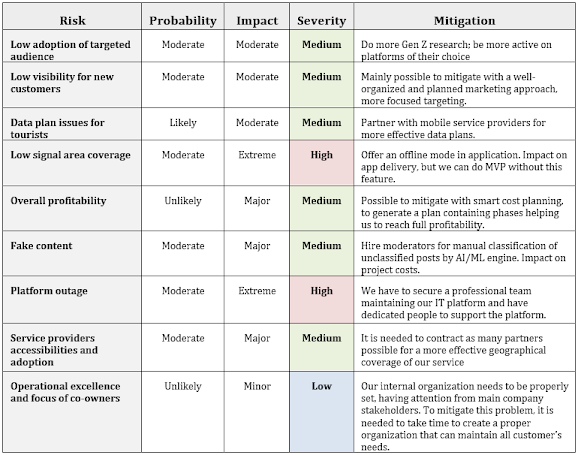Be aware, be prepared - risk management on product launch
While working on a project we are constantly faced with risks — please recall the delusion part as research in Ariely book, mentioned above, and to be clear once more — there are NO projects without risks. But also, be rational, not everything should be identified as a risk, otherwise we will be burdened with unnecessary activities, which will have a direct impact on the entire project.
To keep this under control, we are using probability and impact matrix. Probability is divided into 5 categories: rare, unlikely, moderate, likely, very likely. The impact is divided into 5 categories as well: trivial, minor, moderate, major, extreme. The overall result is divided into three categories: low, medium, and high. Matrix is created according to rules as described in the following figure:
I performed an example of risk assessment and identified the main risks as I foresee for the fictitious online tourism service. For each risk, a probability and impact are defined, according to severity. After that, mitigation actions are defined to decrease the level of selected risks.
Launching and managing a product does not have an end date, it is a repeating process. We constantly track its progress and the only way to do this is to measure the effectiveness of each activity during the process and react accordingly. We can do this with the Risk register as well — keep it updated to be honest with ourselves and have a much clearer view of the expecting outcomes.
How to keep track of the “Low adoption” from the Risk register? Let’s keep it simple:
Generally speaking, each of the identified risks needs to be approached individually. We took the first step — identification, now we have to set the objectives so that we know when we succeeded, then we define the right strategy and make a plan. There’s no shortcut.
Beware — every action has a reaction. For that matter, it is recommended to keep notes on that matter as well, but let’s keep it simple:
[1] Kopal R., Korkut D., „Tehnike kompetitivne analize“, Visoko učilište Effectus, 2014., ISBN: 978–953–57077–7–6






Comments
Post a Comment
Respect...